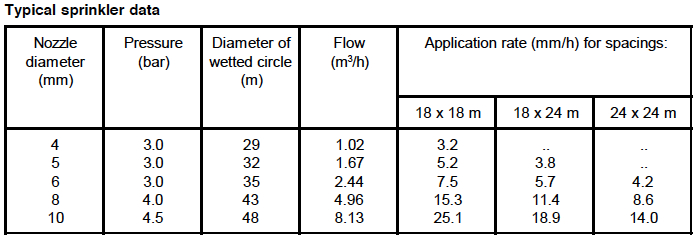Difference between revisions of "Sprinkler"
(Created page with "Sprinkler irrigation involves distributing water in pipes under pressure and spraying it into the air so that it breaks up into small droplets and falls to the ground like natura...") |
(No difference)
|
Revision as of 20:35, 29 May 2012
Sprinkler irrigation involves distributing water in pipes under pressure and spraying it into the air so that it breaks up into small droplets and falls to the ground like natural rainfall. Sprinkler systems are generally more efficient and use less labour than surface irrigation and can be adapted more easily to sandy and erodible soils on undulating ground. There are many types of sprinkler system available, but the most common is a system using portable pipes (aluminium or plastic) supplying rotary impact sprinklers. An individual rotary impact sprinkler produces a circular wetting pattern with poor uniformity. To obtain good uniformity, several sprinklers are always operated close together so that the patterns overlap.
Suitable conditions
Traditional sprinkler irrigation is not so well suited to small farms. Typical spacings for sprinklers are 18 m × 18 m, and so they are not so flexible and adaptable to the multitude of small plots usually found on many farms. An alternative which may be more applicable to small farms is the use of smaller sprinklers connected to the mainline by flexible hoses. This is often called a hose-pull system. These sprinklers have great flexibility in operation and are easily re-located around the farm.
Construction, operations and maintenance
Pressure is an important factor in successful sprinkler operation. Typical operating pressures range from 2 to 6 bar, and so energy requirements can be much greater than for surface irrigation. If sprinklers are working at the pressure recommended by the manufacturer then the distribution will be good. If the pressure is above or below this value then the distribution will be adversely affected. The most common problem is when pressure is too low and this happens when pump and pipes wear, increasing friction and so reducing pressure.

